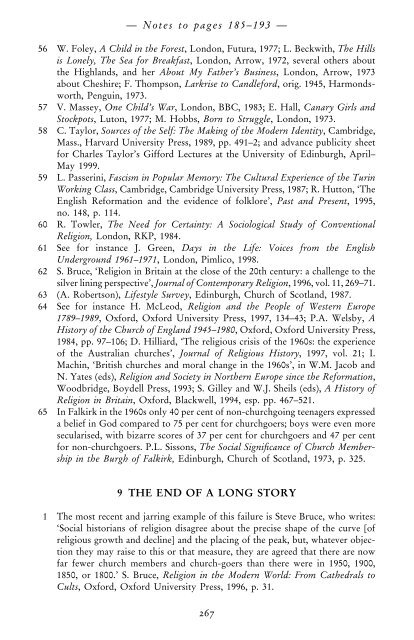The Death of Christian Britain
The Death of Christian Britain
The Death of Christian Britain
You also want an ePaper? Increase the reach of your titles
YUMPU automatically turns print PDFs into web optimized ePapers that Google loves.
— Notes to pages 185–193 —<br />
56 W. Foley, A Child in the Forest, London, Futura, 1977; L. Beckwith, <strong>The</strong> Hills<br />
is Lonely, <strong>The</strong> Sea for Breakfast, London, Arrow, 1972, several others about<br />
the Highlands, and her About My Father’s Business, London, Arrow, 1973<br />
about Cheshire; F. Thompson, Larkrise to Candleford, orig. 1945, Harmondsworth,<br />
Penguin, 1973.<br />
57 V. Massey, One Child’s War, London, BBC, 1983; E. Hall, Canary Girls and<br />
Stockpots, Luton, 1977; M. Hobbs, Born to Struggle, London, 1973.<br />
58 C. Taylor, Sources <strong>of</strong> the Self: <strong>The</strong> Making <strong>of</strong> the Modern Identity, Cambridge,<br />
Mass., Harvard University Press, 1989, pp. 491–2; and advance publicity sheet<br />
for Charles Taylor’s Gifford Lectures at the University <strong>of</strong> Edinburgh, April–<br />
May 1999.<br />
59 L. Passerini, Fascism in Popular Memory: <strong>The</strong> Cultural Experience <strong>of</strong> the Turin<br />
Working Class, Cambridge, Cambridge University Press, 1987; R. Hutton, ‘<strong>The</strong><br />
English Reformation and the evidence <strong>of</strong> folklore’, Past and Present, 1995,<br />
no. 148, p. 114.<br />
60 R. Towler, <strong>The</strong> Need for Certainty: A Sociological Study <strong>of</strong> Conventional<br />
Religion, London, RKP, 1984.<br />
61 See for instance J. Green, Days in the Life: Voices from the English<br />
Underground 1961–1971, London, Pimlico, 1998.<br />
62 S. Bruce, ‘Religion in <strong>Britain</strong> at the close <strong>of</strong> the 20th century: a challenge to the<br />
silver lining perspective’, Journal <strong>of</strong> Contemporary Religion, 1996, vol. 11, 269–71.<br />
63 (A. Robertson), Lifestyle Survey, Edinburgh, Church <strong>of</strong> Scotland, 1987.<br />
64 See for instance H. McLeod, Religion and the People <strong>of</strong> Western Europe<br />
1789–1989, Oxford, Oxford University Press, 1997, 134–43; P.A. Welsby, A<br />
History <strong>of</strong> the Church <strong>of</strong> England 1945–1980, Oxford, Oxford University Press,<br />
1984, pp. 97–106; D. Hilliard, ‘<strong>The</strong> religious crisis <strong>of</strong> the 1960s: the experience<br />
<strong>of</strong> the Australian churches’, Journal <strong>of</strong> Religious History, 1997, vol. 21; I.<br />
Machin, ‘British churches and moral change in the 1960s’, in W.M. Jacob and<br />
N. Yates (eds), Religion and Society in Northern Europe since the Reformation,<br />
Woodbridge, Boydell Press, 1993; S. Gilley and W.J. Sheils (eds), A History <strong>of</strong><br />
Religion in <strong>Britain</strong>, Oxford, Blackwell, 1994, esp. pp. 467–521.<br />
65 In Falkirk in the 1960s only 40 per cent <strong>of</strong> non-churchgoing teenagers expressed<br />
a belief in God compared to 75 per cent for churchgoers; boys were even more<br />
secularised, with bizarre scores <strong>of</strong> 37 per cent for churchgoers and 47 per cent<br />
for non-churchgoers. P.L. Sissons, <strong>The</strong> Social Significance <strong>of</strong> Church Membership<br />
in the Burgh <strong>of</strong> Falkirk, Edinburgh, Church <strong>of</strong> Scotland, 1973, p. 325.<br />
9 THE END OF A LONG STORY<br />
1 <strong>The</strong> most recent and jarring example <strong>of</strong> this failure is Steve Bruce, who writes:<br />
‘Social historians <strong>of</strong> religion disagree about the precise shape <strong>of</strong> the curve [<strong>of</strong><br />
religious growth and decline] and the placing <strong>of</strong> the peak, but, whatever objection<br />
they may raise to this or that measure, they are agreed that there are now<br />
far fewer church members and church-goers than there were in 1950, 1900,<br />
1850, or 1800.’ S. Bruce, Religion in the Modern World: From Cathedrals to<br />
Cults, Oxford, Oxford University Press, 1996, p. 31.<br />
267








